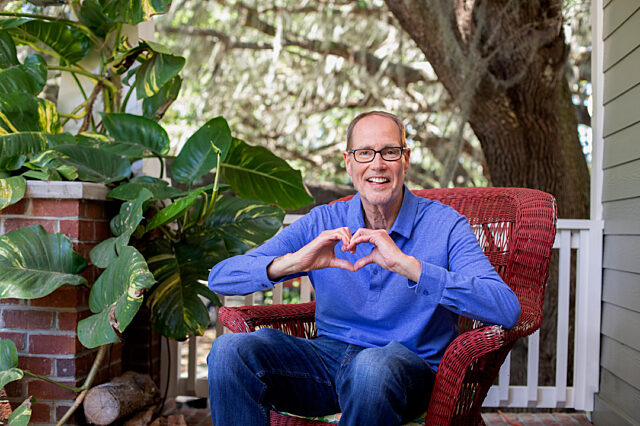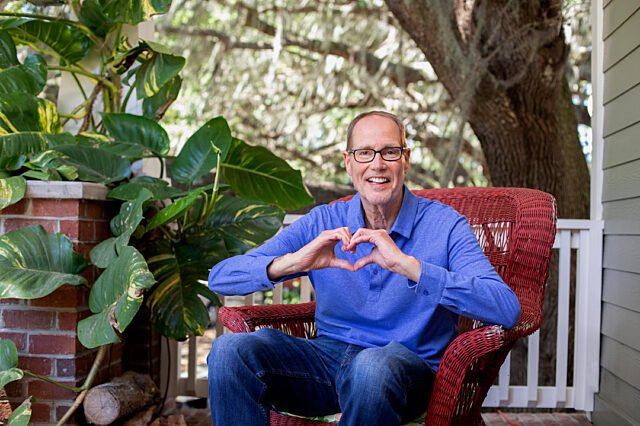Michael gets his beat back
Michael Jansen, 66, is a tall, lean Midwesterner with a soft Missouri drawl, an easy laugh and kind eyes.

Michael Jansen, 66, is a tall, lean Midwesterner with a soft Missouri drawl, an easy laugh and kind eyes. He will tell you that he takes care of himself — walking several miles every day and being mindful of what he eats — and that he delights in having fun with his grandkids. He radiates vitality and a zest for life.
You would never know that he’s on UF Health’s heart transplant list and that he has a left ventricular assist device, or LVAD, implanted to help his failing heart pump blood.
“This is my LVAD,” Jansen says matter-of-factly, holding up a small device that looks like a compact TV remote with a cord leading under his shirt. “It’s the reason I’m alive.”
Jansen has had heart problems since he was a child, but they seldom kept him from doing his favorite activities, like oil painting and exercising. His heart condition worsened during his 30s and he was eventually diagnosed with idiopathic hypertrophic subaortic stenosis, or IHSS, cardiomyopathy — a condition in which the muscle of the heart’s left ventricle thickens and hardens over time, making it difficult for the heart to beat effectively. Early on his condition responded well to medication, and he felt better.
This positive response would prove to be temporary. In 1999, Jansen passed out in the shower. He remembers the incident and feeling fine after it, but he went to see a cardiologist to understand why it happened.
Jansen learned that his heart had developed an intense arrhythmia due to the IHSS, and he needed an implanted defibrillator to maintain a regular heart rhythm.
By 2015, Jansen, then living in Orlando, was convinced by his son, a cardiologist living in Gainesville, to come to UF Health for expert diagnosis and treatment of his heart condition.
“My son first told me to come up here because UF Health had the best program around,” Jansen said. “He introduced me to Dr. Ahmed, and that was kind of the beginning of our relationship.”
At UF Health, Mustafa Ahmed, MD, an associate professor of cardiovascular medicine and the section chief of heart failure at UF Health, discovered that Jansen’s IHSS had progressed into acute heart failure. The left ventricle of Jansen’s heart was so damaged that it could no longer pump effectively. Medications were prescribed that helped, and Jansen made regular trips to Gainesville to see Dr. Ahmed. But a more long-distance approach to treatment was adopted — in collaboration with South Florida cardiologist Dr. Eliezer Hernandez — after Jansen and his wife moved to Palm Beach County in 2016.
“They were trying to treat me long-distance with various, different medications, but it was finally the last episode in 2018 where my doctor in South Florida, along with Dr. Ahmed, said they needed to get me up here (to UF Health) immediately,” Jansen said.
Jansen’s heart failure had dramatically worsened. His physical condition was so fragile that helicopter transport was necessary to get him to Gainesville as quickly as possible. It was Jansen’s first ride in a helicopter, but his thoughts were on the future.
“I had complete trust in Dr. Ahmed and the program up here,” he said. “So just knowing Dr. Ahmed and the fact that if they got me to Shands, I’d be OK.”
At UF Health Shands, Dr. Ahmed and Jansen’s heart team determined that he was in end-stage heart failure and in need of a heart transplant. As a bridge to transplant, open heart surgery to implant an LVAD was an immediate necessity.
Now, Jansen’s blood circulates with the help of this device, which is controlled with an external, battery-powered apparatus small enough to slip into his pant pocket. This controller is connected by a lead to the implanted device in Jansen’s heart, a sort of impeller, that keeps the blood flowing smoothly. Although it’s a relatively small controller, Jansen’s LVAD has had a big impact on his life.
“My life has totally changed,” he said. “I feel like I did when I didn’t have congestive heart failure.”
Jansen’s mobility and activity are back to near-normal levels since his LVAD surgery. The only activity his doctors have excluded is swimming; Jansen jokingly tells his grandkids he might melt if he gets wet.
To help other patients at UF Health considering an LVAD implant, Jansen shares his own experiences, demonstrates how the LVAD works, listens to concerns and provides reassurance that living with an LVAD is an enriching experience that provides a great quality of life. His openness and willingness to share his story has helped many patients on their own heart failure/LVAD surgery journeys.
Even with his LVAD, Jansen remains on the heart transplant list and has moved to Gainesville to be close to UF Health in the event a heart becomes available. “Being on the list for a heart transplant, I jump to answer the phone anytime there’s a 3-5-2 area code,” Jansen said about his wait for a new heart. “If I am fortunate enough to have that happen, I’ll be eternally grateful. If not, I’m living a productive life with my wife, my kids and my seven grandkids — with an LVAD.”
— By Hannah Shelton and Lindy Brounley
About the author

